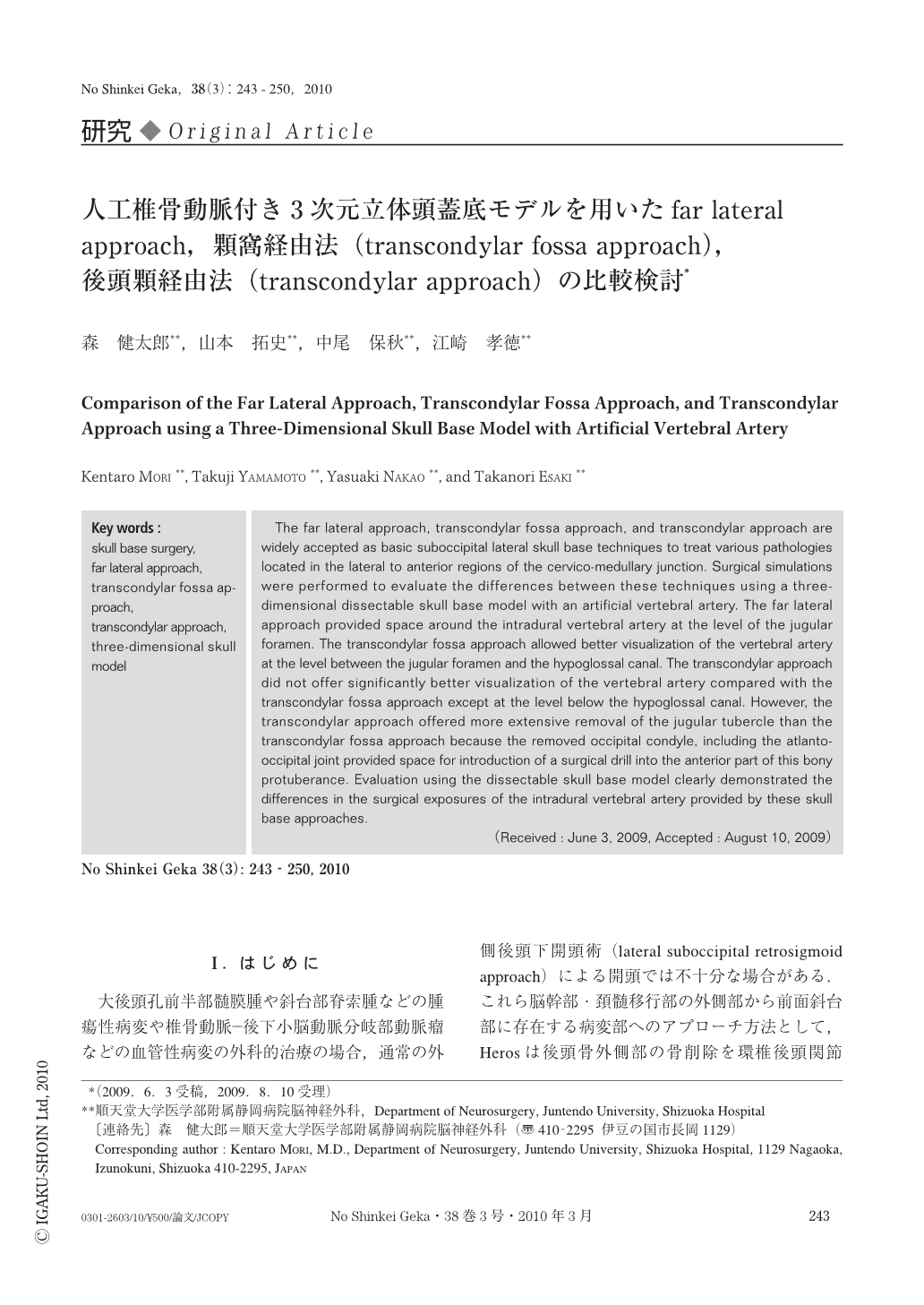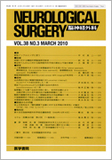Japanese
English
- 有料閲覧
- Abstract 文献概要
- 1ページ目 Look Inside
- 参考文献 Reference
Ⅰ.はじめに
大後頭孔前半部髄膜腫や斜台部脊索腫などの腫瘍性病変や椎骨動脈─後下小脳動脈分岐部動脈瘤などの血管性病変の外科的治療の場合,通常の外側後頭下開頭術(lateral suboccipital retrosigmoid approach)による開頭では不十分な場合がある.これら脳幹部・頚髄移行部の外側部から前面斜台部に存在する病変部へのアプローチ方法として,Herosは後頭骨外側部の骨削除を環椎後頭関節(atlanto-occipital joint)の後端まで加えるfar lateral approachを提唱した4).また,Bertalanffyらはfar lateral approachの骨削除範囲を広げて,環椎後頭関節を含む後頭顆(occipital condyle)の後方3分の1の骨削除と頚静脈結節(jugular tubercle)の硬膜外からの骨削除を加える後頭顆経由法(transcondylar approach)を提唱した2).一方,Matsushimaらは6,7),環椎後頭関節を温存しながら顆窩(condylar fossa)を削開し,頚静脈結節の硬膜外からの削除を加える顆窩経由法(transcondylar fossa approach)を提唱しており,この方法はGilsbachら3)の提唱する後頭顆上頚静脈結節経由法(supracondylar trans-jugular tubercle approach)にほぼ一致する方法と考えられる.これら後頭骨外側部から頭蓋・頚椎移行部にかけての骨削開を行う3つの代表的な手術方法の違いや,硬膜内病変の展開程度の差や手術適応の違いについては,MatsushimaやRhotonなどの優れた研究がある8,9,15).しかしながら,これらの比較検討はcadaver dissectionや実際の手術写真を基にしており,初心者にはややわかりづらいことも事実である.
そこでわれわれは,レーザー溶融粉末積層造形法(selective laser sintering:SLS法)によって作製されたヒト頭蓋骨モデル(大野興業,東京)を用いて,これに人工の硬膜,静脈洞,脳神経,内頚動脈などを付けたモデルを開発し,頭蓋底外科手術のシミュレーションなどに応用する方法を報告してきた10-14).このモデルは,頭蓋底外科に必要な頭蓋骨の表面構造物のみならず,三半規管や含気蜂巣などの骨内部構造も再現されている.さらに,これらの頭蓋骨モデルの人工骨材料はガラスビーズを含み,実際の手術用ドリルを用いて骨削開が可能である.今回われわれは,第1頚椎および第2頚椎上半部が附属した3次元立体頭蓋底モデルに人工椎骨・脳底動脈を再現したモデルを作製し,lateral suboccipital retrosigmoid approachを基に,後頭骨外側部から頭蓋・頚椎移行部にかけての骨削開を順次拡大しながら,far lateral approach,顆窩経由法,後頭顆経由法を再現し,これら3つの後頭骨外側部からのアプローチの違いについて比較検討したので報告する.
The far lateral approach, transcondylar fossa approach, and transcondylar approach are widely accepted as basic suboccipital lateral skull base techniques to treat various pathologies located in the lateral to anterior regions of the cervico-medullary junction. Surgical simulations were performed to evaluate the differences between these techniques using a three-dimensional dissectable skull base model with an artificial vertebral artery. The far lateral approach provided space around the intradural vertebral artery at the level of the jugular foramen. The transcondylar fossa approach allowed better visualization of the vertebral artery at the level between the jugular foramen and the hypoglossal canal. The transcondylar approach did not offer significantly better visualization of the vertebral artery compared with the transcondylar fossa approach except at the level below the hypoglossal canal. However, the transcondylar approach offered more extensive removal of the jugular tubercle than the transcondylar fossa approach because the removed occipital condyle, including the atlanto-occipital joint provided space for introduction of a surgical drill into the anterior part of this bony protuberance. Evaluation using the dissectable skull base model clearly demonstrated the differences in the surgical exposures of the intradural vertebral artery provided by these skull base approaches.

Copyright © 2010, Igaku-Shoin Ltd. All rights reserved.


